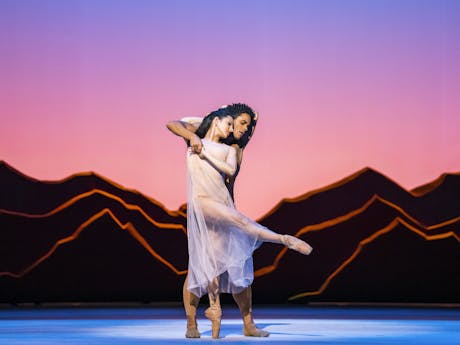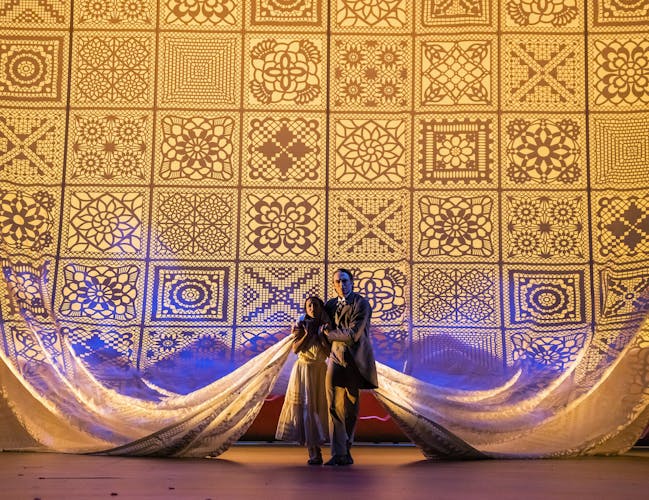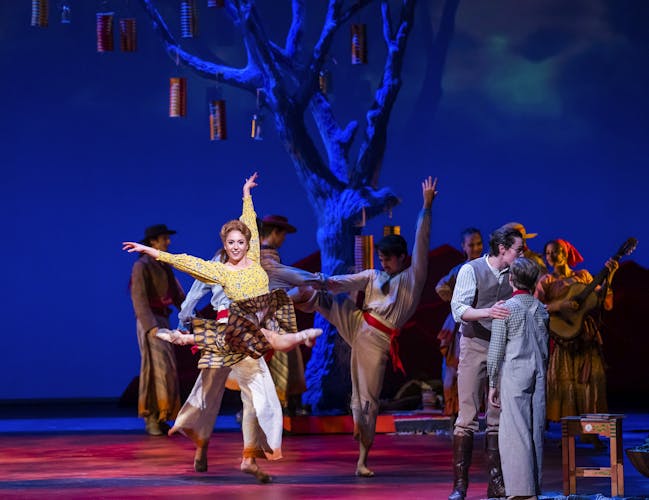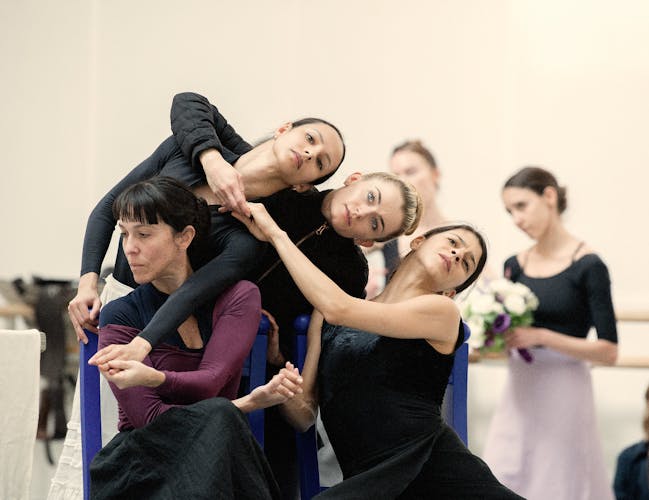Essentials: Like Water for Chocolate
Caught between her yearning for love and an oppressive family tradition, a youngest daughter manifests her inner turmoil in strange and fantastical ways.
Passion, mystery and magic combine as potent ingredients in this ballet by Artistic Associate Christopher Wheeldon, set to music by Joby Talbot and inspired by author Laura Esquivel’s modern classic of magical realism, Like Water for Chocolate.
Quick Facts
What does the saying Like Water for Chocolate mean?
‘Like water for chocolate’ is literally translated from the Mexican phrase ‘como agua para chocolate’ – an idiomatic phrase to mean ‘your emotions are in danger of boiling over’. The title of the story and the ballet reflect the turmoil within the main character Tita, and the strange ways that turmoil plays out.
What is the plot of the ballet Like Water for Chocolate?
Tita grows up in the kitchen of the family cook, surrounded by its sights and smells. She falls in love with Pedro and they want to marry – but she is bound by an unquestioned family tradition: being the youngest daughter, she must remain unmarried to take care of her mother in old age. Caught between her yearning for Pedro and the formidable hand of Mama Elena, Tita’s emotions spill out in her cooking, often in ways unexpected and startling.
Who composed the music for Like Water for Chocolate?
The original score for Like Water for Chocolate is composed by Joby Talbot.
Who Choreographed Like Water for Chocolate?
Christopher Wheeldon choreographed the ballet Like Water for Chocolate.
Who wrote Like Water for Chocolate?
The novel Like Water for Chocolate on which the ballet is based is written by Laura Esquivel.
To find exclusive souvenirs and gifts inspired by Wheeldon's ballet: explore the Like Water for Chocolate collection at the Royal Ballet and Opera Shop.
Characters
Tita – The youngest daughter of the De la Garza household, in love with Pedro but forbidden by family tradition to marry. She has a special gift for cooking.
Pedro – The son of a neighbouring ranchero, in love with Tita. He marries her sister Rosaura in the hope of remaining close to Tita.
Mama Elena – The overbearing matriarch of the De la Garza household. She hides a secret.
Dr John Brown – The family doctor from America. He loves Tita but her passionate feelings are reserved for Pedro.
Nacha – The wise old cook of the De la Garza household and Tita's closest confidant. The two bond over their shared love of food and cooking.
Rosaura – Tita's sister. She marries Pedro but remains jealous of his close relationship with Tita.
Gertrudis – Tita's other sister. She elopes with a revolutionary soldier, and later becomes a famous revolutionary commander.
Juan Alejandrez – A revolutionary soldier who marries Gertrudis.
Roberto – Pedro and Rosaura's first child.
Esperanza – Pedro and Rosaura's second child.
Alex – The son of Dr John by his first wife.
Chencha – The family maid.
Gallery
Like Water for Chocolate synopsis
Pedro: ‘I swear I will love you forever.’
Mama Elena: ‘You know perfectly well that being the youngest daughter means you have to take care of me until the day I die.’
Act I
Scene 1
The De la Garza Ranch
Growing up, Tita is transported by the delicious scents from the kitchen and the delight in food she shares with her beloved Nacha, the family cook. Tita’s free-spirited games with Pedro, the son of a neighbouring ranchero, are quashed by her mother, the formidable widow Elena De la Garza. The childhood friendship develops into flirtatious courtship and a declaration of love. But a family tradition, unquestioned for generations, prevents their union. As the youngest daughter, Tita must remain unmarried to care for her mother in her old age. To Tita’s dismay, the hand of her sister Rosaura is offered to Pedro instead by Mama Elena. Tita is inconsolable as she prepares the wedding cake with Nacha, and her tears inundate the batter. Alone, Nacha tastes the cake mixture and is overcome with intense longing and grief, engulfed by memories of her long-dead fiancé. She curls up on the table and breathes her last.
Scene 2
Rosaura and Pedro’s wedding
Pedro believes his marriage will enable him to stay close to Tita, his one true love. Seeing her sadness, he gives Tita a rose from the wedding bouquet, reassuring her of his unwavering love. As the guests consume the wedding cake, they too are overwhelmed with sorrow and memories of lost loves. Their sadness manifests as violent indigestion. Nacha’s body is carried in. Devastated, Tita believes that she is the cause of all the chaos.
Scene 3
Baby Roberto
A year has passed and Rosaura is exasperated by her attempts to feed her newborn baby. Mama Elena consults the family doctor, John Brown. His efforts to help are in vain and the shrill crying of the baby shreds everyone’s nerves. Distraught, Rosaura leaves the baby with Tita in the kitchen. Something magical takes place and Tita is filled with wonder at the miracle of being able to nurse the baby. Witnessing this, Pedro’s love for her deepens. Mama Elena becomes suspicious of them.
Scene 4
Quail in Rose Petal Sauce
Tita serves the evening meal: quail made with petals from the rose given to her by Pedro at the wedding. While Mama Elena and Rosaura recoil in disgust at the food, Tita’s other sister, Gertrudis, and Pedro take sensual delight in the dish. The food has an erotic effect upon Gertrudis; Tita’s physical desire for Pedro has manifested as an aphrodisiac in her cooking. Summoned by the aroma of rose petals, revolutionary soldier Juan Alejandrez appears and carries a frenzied Gertrudis away on horseback. Mama Elena is consumed with rage.
Scene 5
A Hot, Sleepless Night
Tita and Pedro meet among the sheets of hanging laundry. Their rendezvous is cut short by Mama Elena and a suspicious Rosaura, who are awake and prowling. Elena orders Pedro to leave the ranch and to take Rosaura and Roberto with him.
Scene 6
Tita’s Breakdown
Tita despairs as the two people she loves most – Pedro and Roberto – have gone. The maid, Chencha, brings devastating news that the baby has died. Tita confronts Mama Elena, blaming her for baby Roberto’s death. Elena beats Tita to the ground, causing her a complete emotional collapse. Dr John is summoned to take Tita away to convalesce in Texas.
Act II
Scene 1
Dr John’s House
Away from her mother's tyrannical grasp, Tita has been nursed back to health by Dr John. His son by his first wife plays happily in the garden. Dr John loves Tita deeply and proposes marriage. Although not in love, Tita feels a sense of peace and security and accepts. News arrives from Mexico that Mama Elena has died.
Scene 2
Mama Elena’s Wake
Mama Elena's body is laid out on the table. Rosaura and Pedro are among the mourners, with their new daughter, Esperanza. Tita explores a carved wooden box found hidden in Mama Elena’s bedroom, containing mementos of the old matriarch’s deepest secrets, including a diary. A vision of Mama Elena rises from the table, a younger version of herself. Elena is revealed to have been secretly in love with a man named José. She was forced instead by her parents into a marriage with Juan De la Garza, Tita’s father. The lovers attempted to escape together but José was killed by Elena’s brothers. Aware now of the root of her mother’s unhappiness, Tita forgives her mother. Pedro jealously watches Tita with Dr John while Rosaura keeps a possessive hold on her husband.
Scene 3
The Engagement Dinner
Dr John announces that he and Tita are engaged. Pedro catches Tita alone and once again declares his love. She is unable to resist and the two are swept up in a passionate tryst which summons a ghastly spectre: the ghost of Mama Elena. At once, soldiers arrive in the courtyard and Gertrudis, now a famous revolutionary commander, rides in with Juan Alejandrez whom she has now married. The sisters delight in their reunion.
Scene 4
Campfires
A fiesta is underway celebrating the return of Gertrudis. Tita is wracked with guilt and shudders under the accusing stare of her mother’s ghost. She tells Dr John the truth: that she has always loved Pedro. She returns the engagement ring, feeling unworthy of the kind doctor’s love. Sorrowful but aware of her feelings for Pedro all along, Dr John forgives Tita and leaves. Released, Tita is pulled into the joyous throng. Forgetting her troubles, she dances with Pedro but is once again confronted by the hideous vision of her mother. Tita produces the diary, and the evidence of Mama Elena’s hypocrisy breaks her cruel hold over her daughter. But Tita's victorious elation is short-lived: in a final act of vengeance, the ghost of Mama Elena reveals itself to Pedro, causing his heart to fail.
Act III
Scene 1
Three Rooms
Pedro's health is improving, but Rosaura’s body is rapidly failing, her jealousy feeding her sickness. John and Tita work together to minister to the patients, their old camaraderie rekindled. John's son Alex frolics with Esperanza until Rosaura commands her daughter to her side, echoing Mama Elena's controlling behaviour. Rosaura pulls Esperanza into a suffocating embrace and slumps lifeless onto the pillow. Pedro mourns his dead wife while Tita cries on John's shoulder.
Scene 2
The Ranch
20 years later, another wedding is set to take place in the courtyard of the ranch. Pedro’s daughter, Esperanza, and John’s son, Alex, are married. The families are united in love, the tradition broken. As the celebrations recede, Tita and Pedro are left alone. Their long suffering is over and they are at last free to be together. In a final act of passion, their bodies ignite as they transcend the mortal realm.
Inspired by the book by Laura Esquivel
History
The ballet is an adaptation of Laura Esquivel’s novel of the same name. Like Water for Chocolate was Esquivel’s debut novel, which was published in 1989 to great success. It has inspired a 1992 Golden Globe-nominated film, and a 2024 HBO television series.
Wheeldon was inspired to create a ballet from the novel after seeing the 1992 film adaptation. He was immediately struck by the power of its writing – by its cast of strong female characters, by its potent weaving of domestic drama and magic set in Mexico – a country he’d come to know and love through his friendship with the conductor Alondra de la Parra.
As part of the ballet’s creation process, Wheeldon worked closely with author Laura Esquivel to reshape her richly-layered story as an engrossing new ballet. De la Parra also acted as musical consultant for the original score composed by Joby Talbot, and together with her sister Camilla de la Parra, she helped designer Bob Crowley to research 20th-century Mexican culture to find reference points that would later go on to inform the designs of the ballet.
Like Water for Chocolate premiered in June 2022 at the Royal Opera House, with Francesca Hayward and Marcelino Sambé dancing the principal roles. The ballet would later be performed in America, danced by American Ballet Theatre in March 2023.
Laura Esquivel on Like Water for Chocolate
‘I inherited my love for photography. My grandmother kept family photos inside a trunk that I inherited from my mother and that I currently treasure. Inside lies a collection of photos dating from 1860 to now...There were some photos that especially captured my attention, those were the ones where Tita appeared, a great-aunt who I never even met. She was a beautiful woman who my great-grandmother never let marry. I observed that with the passage of time her face hardened, and her eyes demanded a better destiny.
Trying to give it to her, I wrote Like Water For Chocolate.
I am convinced that the memories of the wonderful montage that Christopher Wheeldon and his team have created will accompany me forever.
The music, the movement, the wonderful performances of the dancers, the costumes, the scenery, the musicians, and the amazing choreography working in unison become powerful. A pure alchemy. They show us what has never been seen before: the heart beat in Tita and Pedro’s chest, Chencha’s last breath and the way her spirit rises to heaven, the way affections are tied and unleashed within the De La Garza family and finally the way they free and purify a castrated heart. All this through moving images full of poetry.’
Magical Realism
Like Water for Chocolate is inspired by Laura Esquivel’s novel of the same name, considered a classic of the magical realism genre. Stories of magical realism feature the inclusion of supernatural or magical elements in everyday settings – other authors considered to write in a magical realist tradition include Isabel Allende, Gabriel García Márquez and Jorge Luis Borges. Some have critiqued the genre itself as an ethnocentric conception of Latin American writing.
Choreography
In Christopher Wheeldon’s choreography for the ballet, he pared down the plot of Laura Esquivel’s novel into its key relationships: the oppressive hold that Mama Elena maintains over her three daughters; the thwarted yearning between Tita and Pedro; the unhappily forced marriage of Pedro to Tita’s sister Rosaura and the gentle affection that Tita finds with Doctor John.
Like his other full-length and abstract works for The Royal Ballet such as Alice’s Adventures in Wonderland, The Winter’s Tale and Corybantic Games, the choreography in Like Water for Chocolate draws from classical ballet vocabulary but it is inflected with contemporary movement as well. To evoke the colour of Mexico, the choreography of Like Water for Chocolate is also infused with earthier rhythms, freer arms and more sensual movements of the torse.
At its heart however, the story of Like Water for Chocolate is a drama that transcends time and place, and its universal themes are the elements that drive the choreography. ‘Laura’s story is so universal in its themes of desire, of repression, and ultimately, of liberation. Her protagonists are strong independent women who rule dominantly, love fiercely and overcome the phantoms of their past, ’says Wheeldon.
Music and Design
The music and designs of the ballet were created by composer Joby Talbot and designer Bob Crowley. Talbot and Crowley, together with lighting designer Natasha Katz, are some of Wheeldon’s most regular collaborators. This dream team has worked together on Wheeldon’s other full-length productions for The Royal Ballet: Alice’s Adventures in Wonderland and The Winter’s Tale.
For the score, Talbot worked together with Mexican conductor Alondra de la Parra, who acted as musical consultant, as well guitarist Tomás Barreiro, who also played the guitar in the opening run of the ballet. Together with de la Parra and Barrerio, Talbot opted to leave out the castanets and harmonic turns that would feed into musical stereotypes of Latin American music. Instead, he focused on associating specific instruments to particular characters: the guitar for Pedro, the ocarina for Tita, the cedar flute for Nacha, and the chimes and wooden rattles for Mama Elena. He also drew on the rhythms of traditional dances such as danzón and petenera, among others.
Inspired by Mexican architect Luis Barragán’s minimalist constructions of light and airy space, Bob Crowley designed the set to be simple. The set of six beams shapeshifts, with the beams moving to reduce or expand the stage – reflective of life inside the De la Garza household under Mama Elena’s oppressive presence, or outside it. The set also allows for the creation of various ambiances and atmospheres, aided by Natasha Katz’s lighting – helping to illustrate the passage of time as the multi-generational story unfolds. The costumes are intentionally naturalistic and organic, against which the story, with its fantastical and unexpected turns, plays out.
Watch now
- Ballet and dance
Like Water for Chocolate (2022)
Journey into this captivating family saga, a modern Mexican classic of magical realism.







